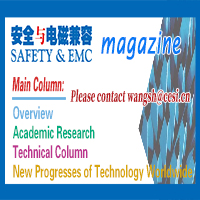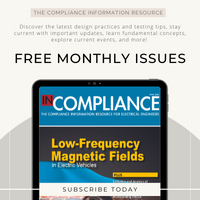HARDWARE EXPERIMENTS
Common Mode Conducted Susceptibility Testing – A Simplified Method
- John Cardinal McCloskey, NASA/Goddard Space Flight Center, United States
This demonstration shows an alternate and simplified method of performing common mode conducted susceptibility (CMCS), also known as bulk cable injection (BCI) on power and signal cables in order to assess a test article’s susceptibility to common mode currents induced on its interconnecting cables. Suggestions are provided to perform the test in a more time-efficient manner while still meeting all objectives.
HARDWARE EXPERIMENTS
Conquering Radiated Emissions When Using Wide-Bandgap Devices
- Jared Quenzer, Würth Elektronik, United States
Wide bandgap devices, primarily silicon-carbide (SiC) and gallium-nitride (GaN) can lead to challenges passing radiated emissions tests due to faster rise times and higher switching frequencies. The speaker will look at a couple of techniques for reducing radiated emissions by first understanding how WBDs can cause more EMI issues. If you have always wondered when to use cable ferrites, how many turns, how many ferrites, and even what value of gate resistance to use for the switching transistor, then please join this session.
HARDWARE EXPERIMENTS
Debugging EMI/EMC Problems in the Near Field
- Arturo Mediano, University of Zaragoza, Spain
EMI troubleshooting is considered black magic. You need some special eyes to "see" the sources and some special "thinking" to find fixes. We have three different strategies to solve an EMC problem: 1) to kill the source, 2) to reduce the coupling mechanism (increasing distance, reorientation, with filters, or shielding), and 3) to increase the immunity of the victim. Usually, the most effective way to solve the problem is to kill the source but many times to find the culprit is not easy. In this demo you will see some experiments demonstrating how useful is the work in the near field to debug EMI/EMC problems. We will use one scope and one spectrum analyser combined with near field probes and near field scanners to find culprits and test solutions. Funny and practical demos!
HARDWARE EXPERIMENTS
Demonstrating the Combined Effects of Testing Radiated Immunity in Accordance with Edition 4.0 of IEC 61000-4-3 Using Multiple Signals
- Dean F Landers, AR RF/Microwave Instrumentation, United States
With the release of the 4th Edition of IEC 61000-4-3, questions arise converning the multiple signal method of testing with regard to over-testing of EUTs, 3rd order harmonic issues when multiple signals are applied, and the overall time savings of applying multiple signals during a single sweep. This experiment will demonstrate and characterize the energy seen by the EUT in both the frequency and time domains, as well as demonstrate the time savings involved when testing multiple signals., display the time savings involved when testing multiple signals, and provide measurements of the power required during multiple signal testing.
HARDWARE EXPERIMENTS
Frequency and Time-domain Calibration of Vibrating intrinsic Reverberation Chambers
- Guillaume Andrieu, Universite de Limoges Faculte des Sciences et Techniques, France
Vibrating intrinsic reverberation chambers (VIRCs) [1] are a particular kind of reverberation chambers (RC) based on the time-varying modification of the cavity shape, generally through a flexible tent made of conducting material. Probably in reason of the continuous movement of the metallized tent, the standard procedure [2] (which probably would require some adjustments in this case) does not mention how to calibrate a VIRC. The aim of this demonstration is therefore to present an experimental approach published recently [3] able to characterize the performance of a VIRC in the frequency domain (as traditionally made for classical RC) using the “well-stirred condition method” [4] based on measurements of an antenna ;but also in the time domain from measurements of the same antenna in the constant-wave mode in order to define the “decorrelation time”, defined as the interval of time to wait in order to collect two independent samples at the same position. The demonstration will be video-recorded. Targeted Audience: Primary: EMC engineers and EMC researchers working with reverberation chambers. Secondary: System design engineers, EMC test engineers and researchers. Duration: 45 minutes. Scenario: Introduction to VIRC Tutorial 1 : Q-factor measurement of a Tutorial 2 : Frequency-domain calibration of a VIRC using the “well-stirred condition method”Tutorial 3 : Time-domain calibration of VIRC measurement of the decorrelation time Conclusions and perspectives Discussion References: [1] F. Leferink, J. C. Boudenot, and W. van Etten, “Experimental results obtained in the vibrating intrinsic reverberation chamber,” in Proc. IEEE Int. Symp. Electromagn. Compat. Symp. Rec., 2000, vol. 2, pp. 639–644. [2] Reverberation Chamber Test Methods, IEC 61000-4-21: January 2011. [3] G. Andrieu, M. Narjes, C. Jullien and N. Ticaud, “Complete Framework for Frequency and Time-Domain Performance Assessment of Vibrating Intrinsic Reverberation Chambers”, IEEE Transactions on Electromagnetic Compatibility, vol. 62, no. 5, October 2020, pp. 1911-1920. [4] G. Andrieu, N. Ticaud, F. Lescoat, and L. Trougnou, “Fast and accurate assessment of the “well stirred condition” of a reverberation chamber from 11 measurements,” IEEE Trans. Electromagn. Compat., vol. 61, no. 4, pp. 974–982, Aug. 2019.
HARDWARE EXPERIMENTS
Fundamental EMC Effects
- Daria Nemashkalo, University of Twente, Netherlands
The demo focuses on presenting various fundamental EMC phenomena using a small and portable setup. This setup is typically used to educate university students learning EMC. It consists of a couple of PCBs that address the fundamental effects such as Lenz's law, crosstalk, discontinuities, parasitics, and transfer impedance. The measurements are performed in time and frequency domain.
HARDWARE EXPERIMENTS
Measurement of mmWave Radiated Spurious Emissions
- Ross Carlton, ETS-Lindgren, Cedar Park, TX, USA
This virtual demonstration will present a multi-axis, effective isotropic radiated power (EIRP) and power spectral density (PSD) measurement solution for a 5G millimeter wave (mmWave) radiating device, as required by FCC Part 30, ETSI/EN 300 400, ETSI/EN 305 550 and other relevant specifications such as those from the 3GPP. Compatibility with traditional semi-anechoic chambers, which are common for EMC measurements, and fully anechoic rooms make this demonstration applicable to nearly any EMC or RF lab that handles wireless intentional transmitters. The demonstration will be of a radiated spurious emissions (RSE) measurement in the mmWave frequency range and will be accompanied by a presentation that explains the applicable standards, highlights the challenges associated with making the RSE measurement, and describes the measurement automation employed. Attendees will learn about some of the challenges of mmWave radiated emissions measurements, how to avoid common mistakes, as well as how improve their test efficiency and productivity.
HARDWARE EXPERIMENTS
Phase-resolved In-house Near-field Scanner
- Morten Sørensen, Syddansk Universitet, Denmark
Centre for Industrial Electronics, University of Southern Denmark, will provide a live demonstration of their in-house near-field scanner. With help of picture recognition, the setup of the near-field scan is very quick. With help of a VNA, the near-field scanner can make phase-resolved near-field scans up to 40 GHz in one scan. I.e., the system can sweep a broad frequency spectrum contrary to commercial scanners on the market which with the VNA only measure single frequencies in zero spans. The concept will be demonstrated on simple microstrips. In addition, near-field scans of power electronic vs. digital electronics will be demonstrated and discussed.
SOFTWARE DEMONSTRATIONS
Radiated Emission and Signal Integrity Analysis of PCBs and Cable Harnesses for Consumer Electronics Applications
- Jaehoon Kim | Smit Navin Baua, Altair Engineering Inc | Altair Engineering Inc, United States | United States
The intense competition in the consumer electronics product market continuously requires shortening the development period and cutting down on the development cost for the timely product launch to the market. To satisfy these requirements, the PCB (Printed Circuit Board) design technology has been steadily improved for quite some time. However, the PCB designs still demand engineering challenges due to the increased EMI (Electromagnetic Interference) of clock speeds as well as the increasing density of digital designs. At the same time, more and more electronic products are introduced with High-Definition Multimedia Interface (HDMI) cable connections. As such, not only the radiation emissions from PCBs but also the conducted and radiated emissions from the attached HDMI cables is of significant concern. Additionally, the quality of the PCB signal transmitted to the cable is degraded by the cable attached to the PCB. Therefore, it is highly recommended to perform the radiated emission (RE) and signal integrity (SI) analysis of the PCBs to mitigate any potential EMI issues. In this demonstration, the procedure of analyzing the signal quality and radiation effects of the PCB with a high data rate cable, specifically HDMI, will be presented. Additionally, techniques to mitigate the radiated and conducted emissions from HDMI cables will also be presented.
HARDWARE EXPERIMENTS
Radiated Emissions Testing per CISPR 22/32 using Remote Location
- Jack McFadden, ETS-Lindgren, Cedar Park, TX, USA
This virtual demonstration will discuss the test setup and test methodology for performing RF radiated emissions testing in accordance with CISPR22/32 using a 3m Semi-Anechoic Chamber and Emissions System. A fully functional and compliant test system is used to demonstrate testing of an actual EUT. This virtual demonstration will be conducted using test automation as well as vision-based software to illustrate techniques to increase quality and efficiency. The test control will be remote while the system is located within a laboratory. The program will start with a presentation that highlights the challenges and common mistakes when utilizing this test method. The following live demo will show the material presented in a real-world environment. Attendees will learn how to avoid common mistakes as well as improve their test efficiency and productivity.
HARDWARE EXPERIMENTS
Transfer Impedance Measurement, from Simple to Complex Setup
- Charles Jullien, Safran Electrical and Power, France
The electrical wiring interconnection system (EWIS) can be protected either by shielding, i.e. by placing a conductive screen that protects and limits the electromagnetic radiation and coupling, either by separating the links from the others with a certain distance in order to create a segregation between the signals and powers transmitted. In the first case, we must be able to characterize the effectiveness of the shielding. For a large number of applications, the frequency band used rarely exceeds a few GHz. So we can divide the problem of a shielded cable into two sub-problems that we link with a transfer function: the transfer impedance. These internal (core VS shielding) and external (shielding VS environment) domains are linked by the transfer impedance which determines the interaction of one domain on the other and vice versa. The demonstration shows the evolution in complexity of the transfer impedance (Zt) characterization methods. Starting from a sample of a coaxial cable and a setup requiring only a few materials, we will carry out several assemblies allowing the Zt to be measured: triaxial bench [2], triaxial bench with shielding discontinuity, line injection and localized injection . This latter method will highlight the future of transfer impedance measurement by localized injection and its potential for extending the characterization of high frequency shields. The addressed topics: Transfer impedance; Shielding; Triaxial bench; Injection line; Localized injection; Cables; Harnesses; Connectors The demonstration will help the audience to test shielding cables, connectors and their assemblies for a wide range of frequency. Targeted Audience: Primary: EMC engineers in electric product industries Secondary: Cable, connector and their assembly designers; EMC researchers. Duration: 45min



